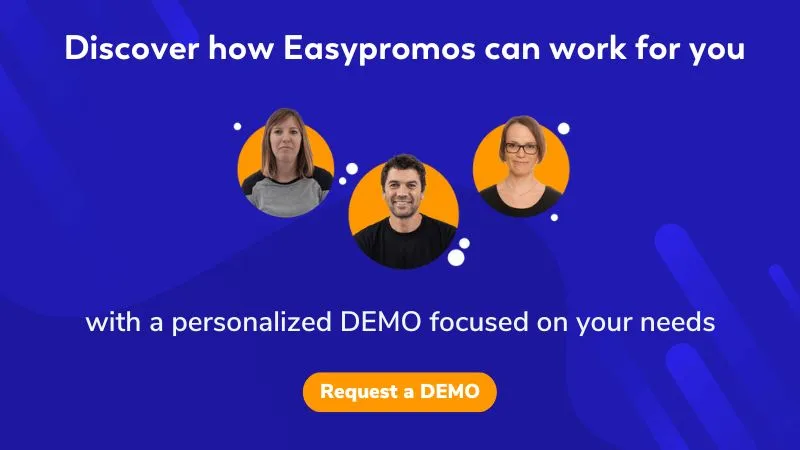Easypromos offers all the tools to verify customers’ purchases. In this article, we will go over all the relevant details and examples.
Using single-use codes
In this type of Purchase to Win promotion, customers receive a single-use code after the purchase, which they use to access the promotion.
- If the purchase takes place at a brick-and-mortar point of sale, it is advisable to give the code printed on a card with a QR code that links to the promotion and the single-use code.
- For online purchases, it is best to include the code in the thank you email or purchase confirmation email.
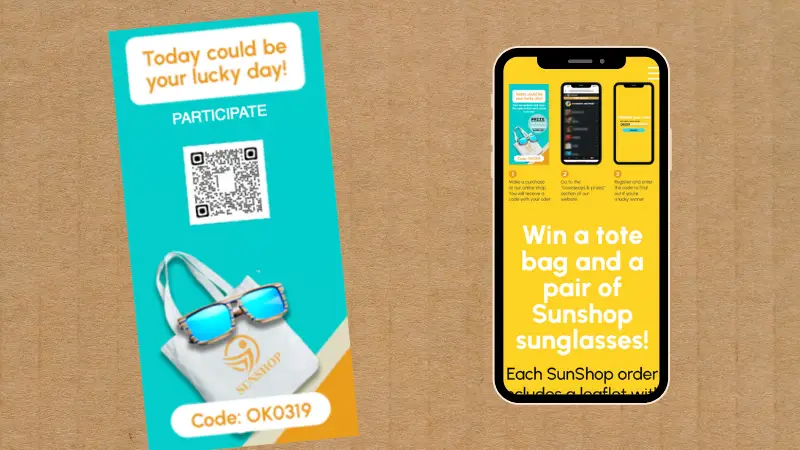
Advantages of single-use codes
- It is a reliable method to ensure that only paying customers participate in the promotion.
- It is easy to communicate as users are used to managing codes to access exclusive promotions.
- Many tools facilitate the generation of single-use codes: ChatGPT, Excel, etc.
- Allows the mass management of codes. The Easypromos Redeem Codes application can manage promotions involving millions of codes.
Disadvantages of single-use codes
- For physical stores, it is necessary to distribute a set of codes to each establishment.
- If the code is distributed in print format, the cards containing the code and QR access to the promotion must be designed and printed.
- If the code is distributed digitally, the feature to generate single-use codes in the purchase process has to be enabled, which requires involving the IT team.
Common case uses
- Single-use code validation is ideal for retail promotions where millions of codes are distributed. For example, codes printed under a yogurt lid or inside a soda cap.
- Code validation is recommendable whenever there it is possible to place a code inside a product’s packaging.
- Code validation works well when combined with the “virtual coins” feature. As customers validate the codes they receive, they accumulate virtual coins that can be exchanged for prizes.
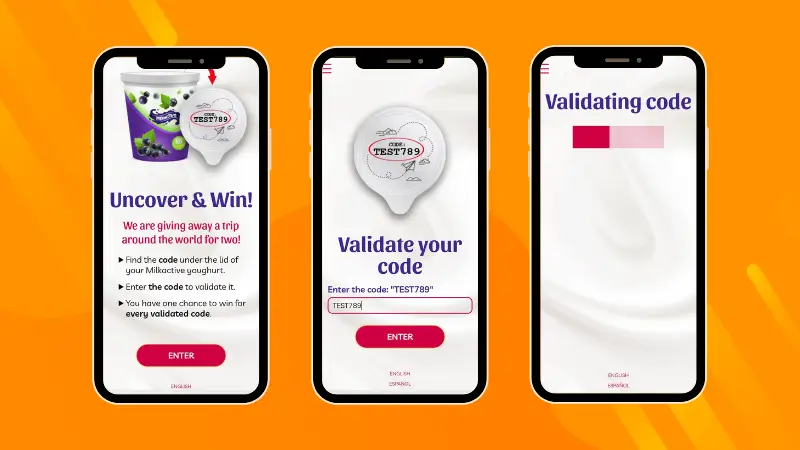
Automatic purchase receipt validation with OCR
The customer must upload an image of the purchase receipt. The system scans it and determines the validity of the receipt in real-time. The entire process takes just a few seconds.
- Using OCR technology, the system can read any textual information on the receipt. The validation rules are applied based on what the system reads.
- The rules for determining whether a ticket is valid are configured by the promotion administrator. The rules can take into account the total amount of the receipt, the date, and any text string that appears printed on the ticket.
- Promotional actions with automatic ticket validation are typically applied to receipts over a specific total amount. For example: Upload a ticket from our store over €20 and participate in a Scratch and Win dynamic.
- The concept of a “purchase receipt” is quite broad. The system can validate a classic purchase receipt and other documents, such as a movie ticket or a race bib number. For example, if a user participated in a Marathon, they can upload their bib number to win direct prizes.
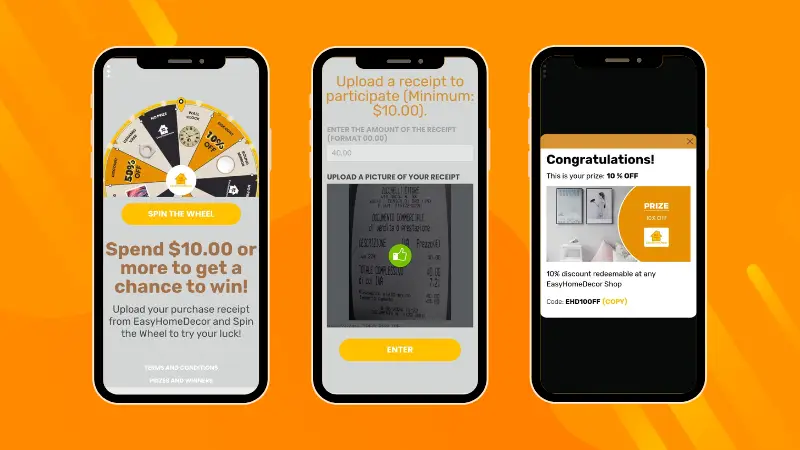
Advantages of the OCR validation
- The main advantage of the Validate Receipts app is its full automation capability. Once the validation process is configured, no extra intervention is needed and the daily operation works in “automatic pilot” mode.
- Ease of use: the buyer is completely autonomous when participating in the promotion and does not have to interact with the store staff. Usually, they scan the QR code found in the store to participate; first, they register, then upload their receipt, and if valid, they can participate in the promotional dynamic.
- Management of accumulated receipts by amount. Design dynamics to reward customers if they reach a total sum. For example, rewarding customers who exceed $1,000 in purchases. This amount can be reached with a single receipt of $1,000 or 10 receipts of €100.
- The Easypromos OCR technology includes duplicate management. The system detects if the same file has been uploaded more than once and if a user tries to upload a different photo of the same ticket. Additionally, to prevent duplicates, you can define a validation rule on the receipt numbering, asking the user to enter the receipt number, and the system will verify that it appears on the ticket and has not been used before.
- Data analysis: the system stores the textual information of all receipts. This information can be retrieved for later analysis.
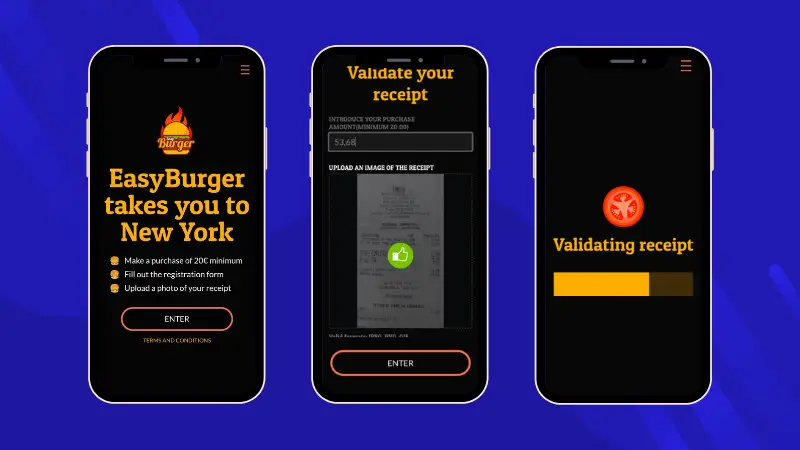
Disadvantages of OCR validation
- Although validation rules can be very sophisticated, it is challenging to establish a set of rules that cover many different receipt formats. Therefore, a disadvantage of OCR is that it can only be used in situations with few ticket formats.
- It is impossible to set validation rules that control the amount of a particular product. You can only verify the presence of that product but not how many units are purchased. For example: You can decide that a ticket is valid if the text on the receipt includes product XYZ, but you cannot establish a rule that controls how much of the total corresponds to product XYZ. The only amount you can control is the total ticket amount (including taxes).
Common case uses
- OCR ticket validation is optimal when working with a single receipt format. For example, promotions for a gas station chain, a supermarket chain, a coffee shop chain, or a fast food chain. Since only one format is available, you can be very specific when creating the validation rules.
- Another situation where OCR validation is very suitable is when you control the POS system because you can add specific phrases or hashtags for the ongoing promotion. You can then include these phrases as a requirement in the receipt validation rules. Additionally, you can also add a QR code to access the promotion so that the ticket includes all the necessary information to participate.
- If you wish to distribute direct prizes without prior manual validation, for example, in a fast food chain, customers get a spin of a prize wheel for every ticket over $20 with the wheel offering prizes like free drinks and fries. OCR validation is the only system that allows the promotion to operate autonomously, on a large scale, with minimal monitoring, and in ‘auto-pilot’ mode.
Receipt validation with pre-moderation
The customer uploads an image of the purchase receipt, and the participation is paused until the receipt is reviewed and validated by someone from the organization.
- Once the receipt has been validated, the customer receives an email with a link inviting them to continue participating.
- If the ticket is invalid, the customer receives an email indicating why the ticket is not valid.
- This validation flow supports the same dynamics as OCR validation. However, it is not executed in real time.
- The promotion organizer will have a section in the Easypromos back office where they can visualize all the receipts received and can easily validate or reject them.
- The pre-moderation system is designed to be outsourced, allowing an external team to focus solely on receipt validation.
- During manual ticket validation, the moderator can assign more participation chances based on what the ticket shows. For example, in the case of a digital stamp card, the moderator could give stamps based on the total amount of the receipt.
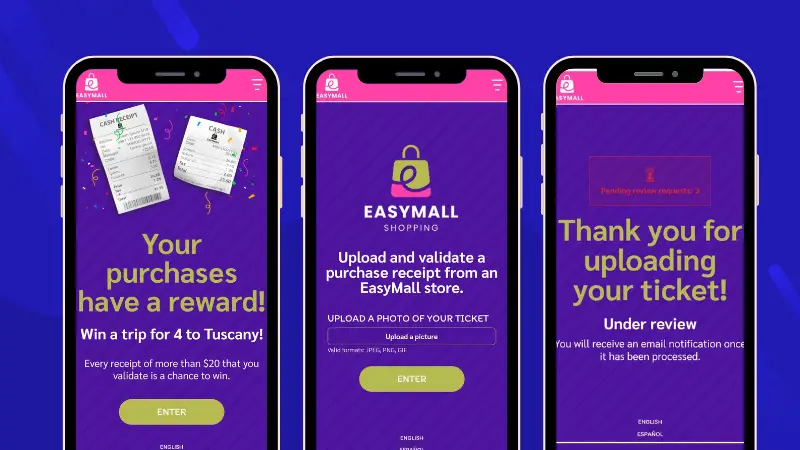
Advantages of receipt pre-moderation
- Pre-moderation makes it possible to reward purchases in scenarios with many different receipt formats. For example, when a product is sold in many supermarkets and each store has its ticket own format.
- As with pre-moderation, every ticket goes through a person’s review, you can create promotions with complex rules. For example, rewarding customers who have bought X units of a specific product or spent more than X amount on your brand’s products.
Disadvantages or receipt pre-moderation
- The user experience is not as smooth as with OCR validation because the user’s participation is paused until their ticket has been reviewed. The validation time depends on the number of receipts in the moderation queue and how many people are available to review receipts.
- More resources (people and time) are needed to speed up the validation cycle as much as possible. In national promotions where hundreds of thousands of tickets are generated, it is important to correctly size the team of moderators to ensure receipts are validated as quickly as possible, or customers may lose interest in the promotion.
Common case uses
- The most common scenario involves consumer brand promotions in stores and supermarkets. Since it is impossible to create a common set of rules for all the receipt formats where their products appear, manual pre-moderation is usually implemented.
- Another situation where manual pre-moderation is used is to reward customers based on the number of units of a specific product purchased. For example, a cola brand wants to reward everyone who has bought a can of soda and a bag of chips. This type of dynamic is only possible with manual ticket validation.
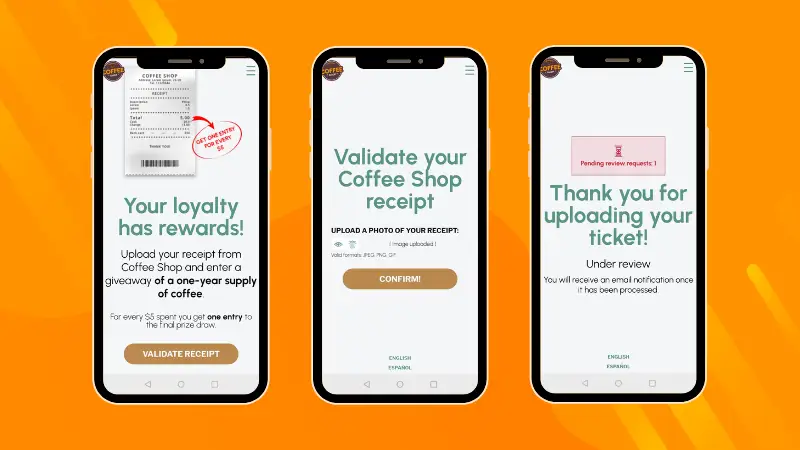
Receipt validation after the final prize draw
The customer uploads an image of the purchase receipt and participates in a final draw. After randomly selecting the winner and the alternates, the promotion organizers review the winner’s receipts to ensure they are valid. If any receipt does not meet the participation conditions, the winner is replaced by the first alternate, and so on until a winner with a valid receipt is found.
- This type of promotion can only be carried out with promotions with a final prize draw and it is not recommendable for direct prize dynamics.
- It is the digital version of the old-days dynamics where product labels had to be mailed in, and a prize draw was carried out among all participants.
- The key to this type of promotion is that, even if it is massive and thousands or hundreds of thousands of tickets are received, the organizer only has to validate the winner’s and/or alternates’ receipts. Purchase receipts uploaded by the rest of participants can be disregarded.
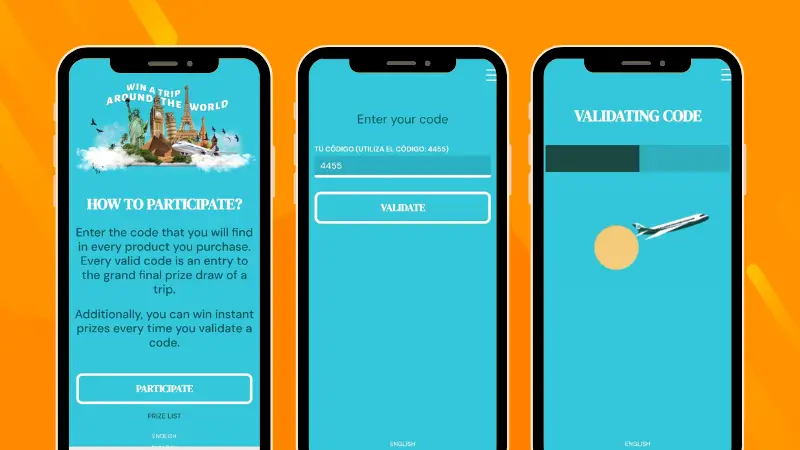
Advantages of receipt validation after the final prize draw
- It is the simplest validation system available. The configuration is minimal.
- Seamless participation flow. The customer uploads the receipt and their participation is immediately validated.
- It has low incident management because there are no rejected purchase receipts, keeping complaints to almost zero.
Disadvantages or receipt validation with pre-moderation
- It is a type of validation that only works with a final prize draw.
- It is paramount to make it clear in the terms and conditions that if the winner submits a receipt that does not meet the promotion conditions, they will be automatically disqualified.
Common use cases
- A common case is that of an association of business owners that wants to hold a Christmas raffle among all customers who have purchased in any of the participating stores. Since these are different shops with different receipt formats, OCR is not an option, so the receipt validation after the final prize draw is the optimal solution.
- It is also used by consumer brands that want to reward their customers and do not want to use pre-moderation.
Purchase validation through a dynamic QR code
In this scenario, the customer scans a QR code provided by the shop assistant during the purchase process. This dynamic is closely linked to promotions such as a digital Stamp Card where the customer receives a stamp for each purchase, consumption, or service. Picture a coffee shop with a digital stamp card to reinforce customer loyalty and recurrence. After ordering a coffee and a croissant, the staff who attended the customer will show them a QR code. As the customer scans it, the card is automatically stamped.
- The Easypromos platform manages both static and dynamic QR codes. In the case of ‘Purchase to Win’ promotions, we recommend using dynamic QRs to ensure that the same QR cannot be reused.
- Easypromos features an integrated dynamic QR code generator within the platform’s tools. Store staff only need a mobile phone or tablet to show the QR code to the customer.
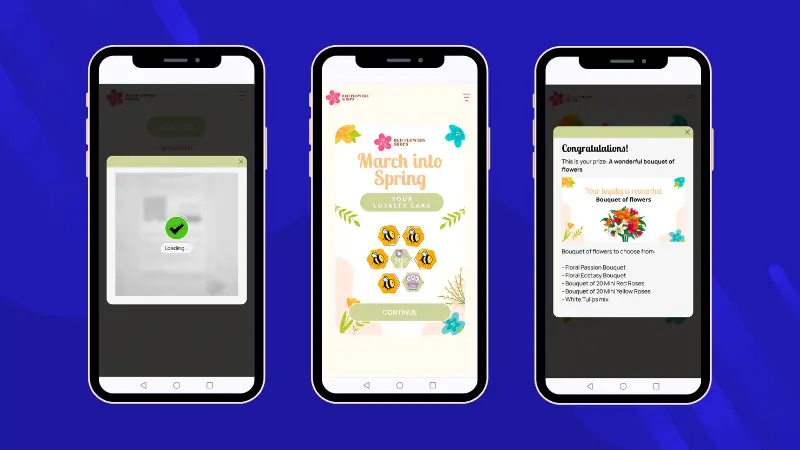
Advantages of receipt validation through dynamic QR code
- The purchase validation process with a dynamic QR transfers the experience of getting a stamp from the establishment to the digital world. There is no physical card, no need to download any app or store anything in the phone’s wallet.
- The customer does not have to worry about managing the card. By scanning the dynamic QR, they directly access the digital stamp card. This way, the customer does not need to remember where they saved it or if they have previously registered. The system recognizes if it is their first time participating and, in that case, offers a new card. If they participated before, it retrieves the card with the accumulated stamps.
- No additional software is required to scan the QR; it is done directly from the phone’s native camera application.
- Since it is a dynamic QR, there is no possibility of fraud. Once scanned, the QR cannot be reused and will show ‘Invalid QR’ if scanned again.
- If a customer takes a photo of the QR or saves the associated URL on their phone, nothing will happen, as the QR becomes invalid after the first use.
- Store staff can assign more than one stamp in a single QR scan. For example, if you choose to give a stamp for every $10 spent and the customer spends $30, three stamps will be awarded directly when scanning the codes.
Disadvantages of receipt validation through dynamic QR codes
- The main drawback is that scanning a dynamic QR is not a fully automated process; there must always be intervention from the store staff to show the QR to the customer.
- Store staff need a mobile phone or tablet to access the Easypromos vendor portal, where the dynamic QR generator is located.
- It is important to train the staff on how to use the Easypromos vendor portal. The training, however, is very simple as the portal has a ‘generate code’, but it is still necessary.
Common use cases
- The most straightforward case would be a physical store that wants to reward its customers’ purchases and does not want to implement code or OCR receipt validation. After paying for their purchase, the store staff will show the customer the dynamic QR and encourage them to participate in the promotion; for example, a Scratch and Win for all purchases over $15.
- The scenario where dynamic QR validation makes the most sense is when implementing digital stamp cards for local businesses: coffee shops, beauty centers, and sports clubs with court rentals (soccer, paddle tennis, tennis, etc.).
- Another ideal situation is in promotions where direct prizes are distributed, but there are many formats of purchase receipts, and pre-moderation cannot be applied. For example, promotions in a shopping center where all purchases over €30 are rewarded.
Purchase validation with integration with the sales system
In this case, the promotion organizer has an IT application to attribute purchases to their customers. The paradigm example is an e-commerce application but also applies to loyalty portals that digitally collect sales made in physical stores.
Easypromos has a comprehensive catalog of APIs to integrate with any sales system and reward buyers with direct prizes and dynamics available only to those who have made a purchase. For example, for every purchase over $10 from e-commerce, customers get a chance to spin a prize wheel.
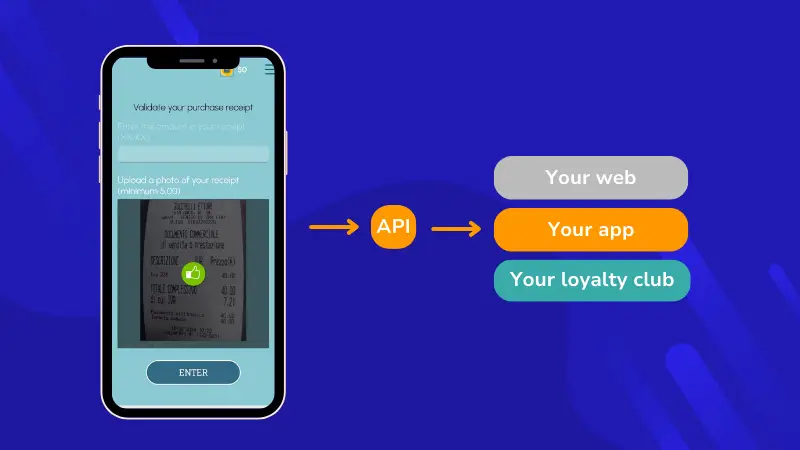
Advantages of integrating purchase validation with sales system
- The user experience is very natural. The user perceives participation in the promotion as something fully integrated into the e-commerce.
- It does not require the voluntary participation of the customer; the promotion appears as another step in the purchase process. For example: after buying a plane ticket, the system allows the user to participate in a Scratch and Win where they can win direct discounts for their next purchase.
- It is possible to automatically segment customers and offer different dynamics and prizes based on the segmentation. For example, Gold customers have access to different promotions than Silver customers.
- The promotion organizer has total control over when and at what point in the purchase flow the promotion will appear.
- Integration with the sales system is total: Easypromos integrates with the registered user system, shows up in a widget if the application is web-based, or in a webview if the application is mobile-based.
- Everything that happens within the promotion in Easypromos can be exported via REST API or Webhook. Picture a promotion within a loyalty portal. Users who have spent more than $100 in the last month can participate in a prize wheel. The wheel distributes virtual coins. The customer spins the wheel and gets 1,000 virtual coins, and these virtual coins update their coin balance in real time on the brand’s loyalty portal.
- Any Easypromos dynamic can be integrated with an external sales system, not only direct prize dynamics but also games, quiz dynamics, giveaways, digital stamp cards, and multi-stage promotions.
Disadvantages of the integration with the sales system
- The main drawback is that, unlike the other methods, this requires the intervention of the promotion organizer’s technical department.
- Conceptually, the integration is very simple, it can be summarized in a few calls to the Easypromos API, but the promotion organizer will have to carry out some degree of development on their e-commerce, mobile application, or loyalty portal to make those calls.
- Since development is necessary, this type of integration takes more implementation time than the other alternatives presented in this article.
Common case uses
- The most frequent scenario to consider integration with the sales system is when you wish to reward the customer within the purchase flow. For example, in an e-commerce, once the purchase has been paid for, a screen may come up saying “Participate in our Scratch and Win”.
- Given the technical nature of this option, it might seem that it only applies to online purchases, but you can also reward purchases made in physical stores. This is common in loyalty portals where customers accumulate points for all purchases made in the brand’s physical stores. The portal registers all purchases, so it’s just a matter of deciding when to show the Easypromos promotion. For example, a call to action can be activated when the customer has exceeded $500 in purchases. More sophisticated actions can also be implemented, such as giving stamps based on the type of product purchased and rewarding upon completing the stamp card to stimulate the sale of a specific range of products.
Conclusions
Easypromos offers a broad, robust, and flexible set of tools to verify purchases in “Purchase to Win” promotions, adapting to different needs and scenarios.
If you want to learn more about them or see how these solutions can be integrated into your business, contact our sales team. We will be happy to set up a personalized demo or provide you with more information regarding our tools.
